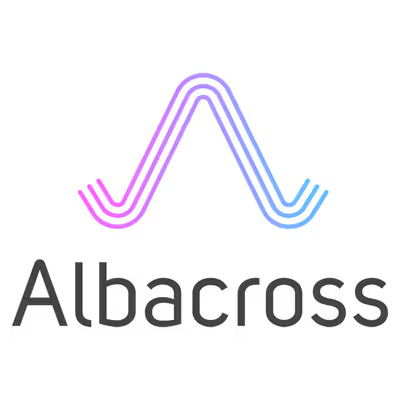CallHippo Alternatives
A direct comparison of 10 CallHippo alternatives. We analyze features, pricing, and performance to help you choose the right provider.
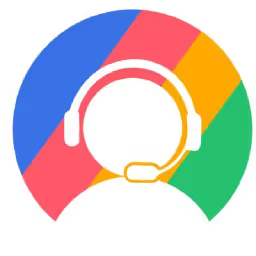
CallHippo is a popular choice for many businesses, and for good reason. It's known for being easy to use and having helpful customer support. Its features, like the Power Dialer, work well for teams that need to make many calls quickly.
However, no tool is perfect. Some users report high costs and occasional dialer or connection issues, which might lead you to look for an alternative. We've analyzed the top options based on G2 reviews to help you compare. Let's get started.
Consider 11x For Digital Sales Workers
For sales efforts that go beyond dialing, consider adding a digital worker. 11x offers autonomous agents to handle research, outreach, and follow-ups, which can support your existing team.
11x is a GTM platform that uses AI agents to manage the sales process. An agent named Alice finds prospects, handles outreach on email and LinkedIn, and maintains the CRM. A second agent, Julian, qualifies inbound leads and books meetings for the team.
The platform consolidates functions like data enrichment, sales outreach, and email warmup. This approach is designed to replace the need for multiple, separate tools in a go-to-market stack.
CallHippo Alternatives
Here is a detailed breakdown of the top CallHippo alternatives. We analyze each tool's pricing, features, and how it compares to CallHippo in terms of advantages and drawbacks.
1) RingCentral MVP
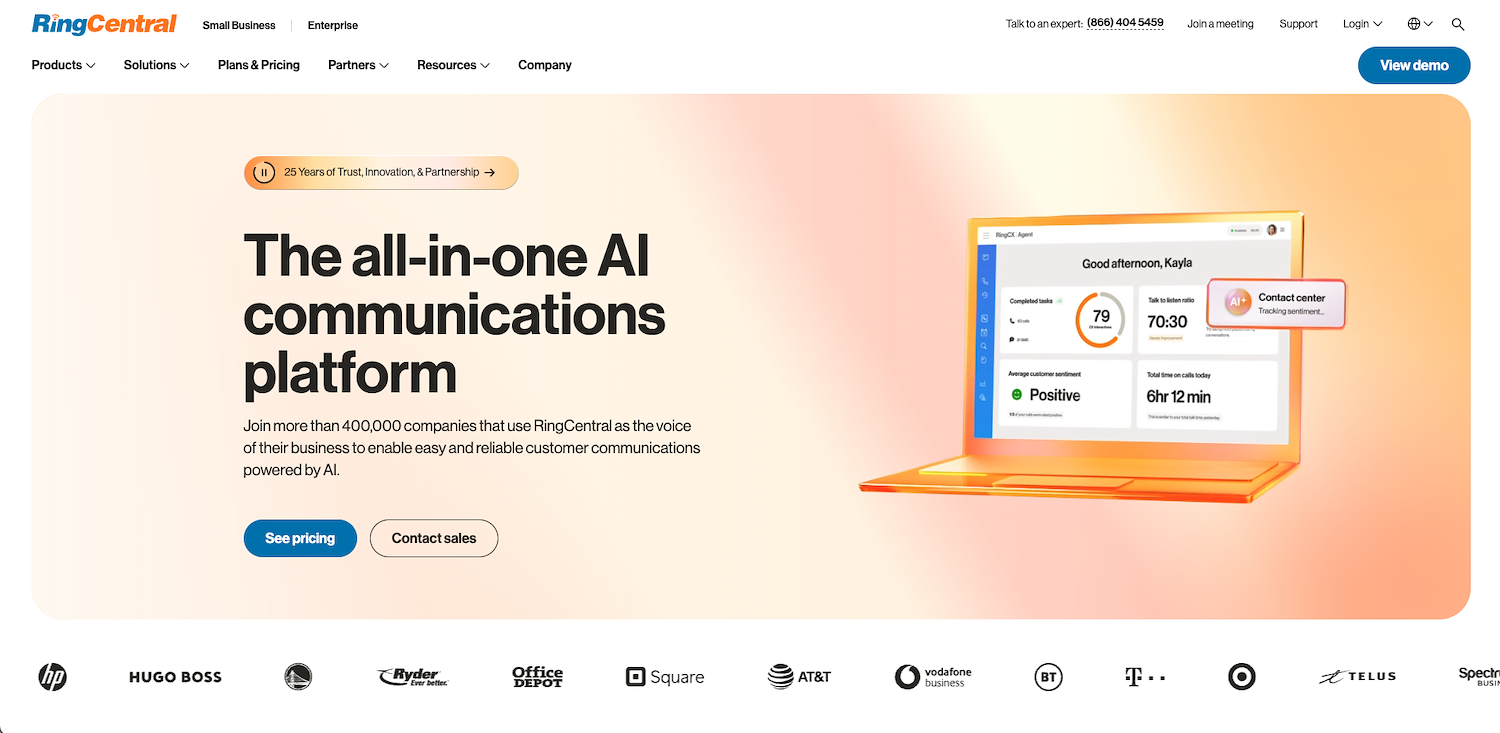
RingCentral MVP is a unified platform for business communications. It combines phone service, video meetings, and team messages in a single application for businesses of various sizes.
Common uses include customer support calls and internal team collaboration. The system provides phone dialer capabilities for sales and service departments to manage outbound and inbound calls.
RingCentral MVP's Main Features
- Combines phone service, video meetings, and team messaging in a single application.
- Offers phone dialer capabilities for sales and service departments to manage outbound and inbound calls.
- Supports unified communications for both customer support and internal team collaboration.
How RingCentral MVP Compares to CallHippo
Average Review Score: 4.0/5 stars based on 154 G2 reviews.
- RingCentral provides an omnichannel solution with voice and over 30 digital channels like chat and social media. This is a broader scope compared to CallHippo's primary focus on voice calls.
- It connects with over 300 prebuilt applications, which offers more flexibility to integrate with your existing software stack than the options available with CallHippo.
- The platform includes AI-powered virtual agents for customer self-service. These bots can resolve customer issues automatically, an advanced feature not central to CallHippo's dialer system.
- This solution unifies phone, video meetings, and team messaging in one application. In comparison, CallHippo operates more as a specialized business phone system.
Potential Drawbacks Compared to CallHippo
- The platform's setup can be complex, with an implementation time of around two months. This is a longer process compared to the more straightforward setup of CallHippo.
- Its extensive features often mean a higher price. This cost may be a factor for smaller teams that do not need a full unified communications suite like the one RingCentral offers.
- It may lack some specialized dialer functions that CallHippo provides. For instance, CallHippo's Power Dialer is a core feature for sales teams, which is not a primary focus for RingCentral.
Pricing and Cost-Effectiveness
CallHippo has transparent pricing tiers at $16, $24, and $40 per user. RingCentral MVP does not publish its prices, but its broader feature set implies a higher cost. CallHippo is better for budget-focused teams, while RingCentral suits those needing a complete communications platform.
2) Aircall
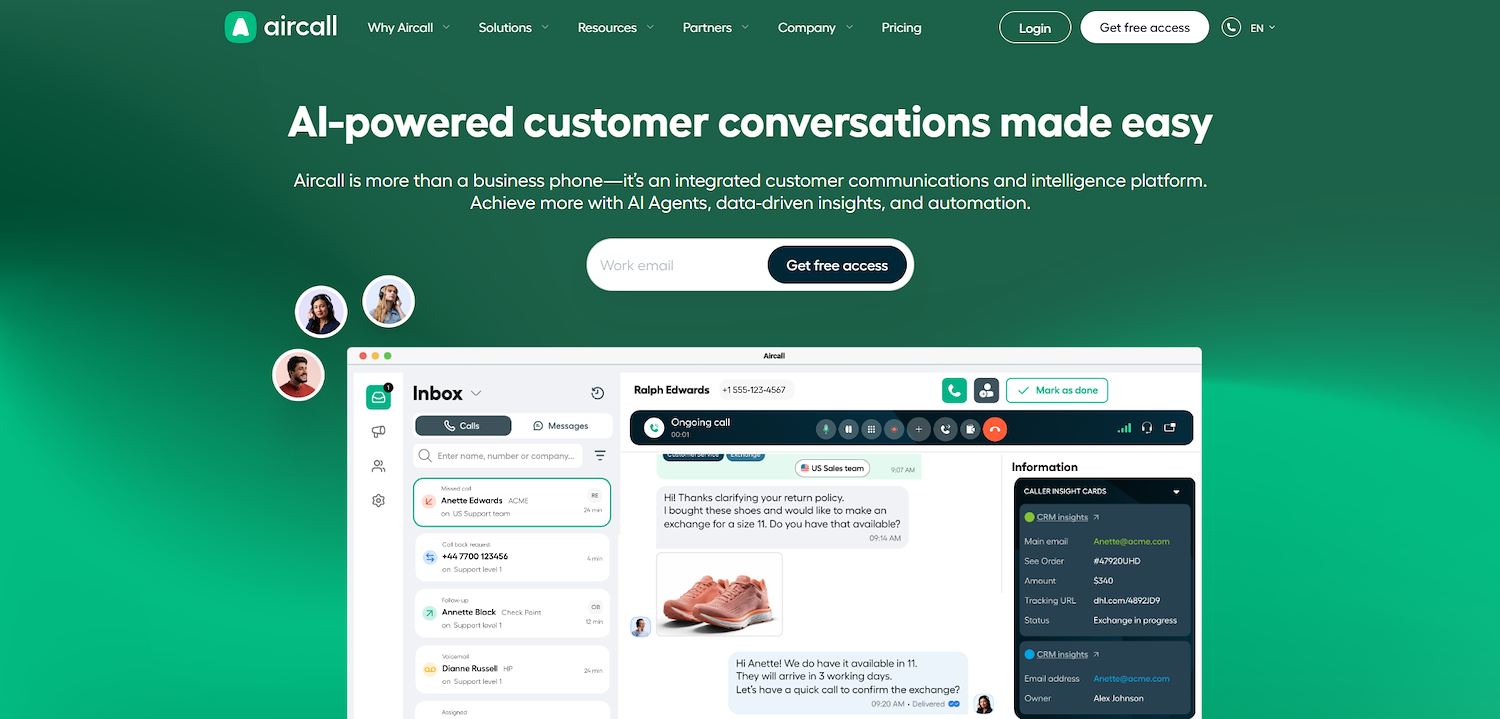
Aircall is a cloud platform for customer communication that combines voice, SMS, and WhatsApp. It serves sales and support teams with tools for outbound and inbound calls. For sales, it offers a Power Dialer and click-to-dial functions. For support, it uses IVR and smart call queues.
The system also provides AI agents for automated call management and connects with over 100 applications. Deployment is hardware-free.
Aircall's Main Features
- Provides an AI voice agent to handle, qualify, and route inbound calls autonomously 24/7.
- Offers real-time coaching during live calls and automates follow-up workflows with its AI Assist feature.
- Combines calls, SMS, and WhatsApp conversations into a single, unified workspace for agents.
- Connects with over 100 native applications, including platforms like Salesforce, HubSpot, and Zendesk.
How Aircall Compares to CallHippo
Average Review Score: 4.4/5 stars based on 1,314 G2 reviews.
- Aircall combines calls, SMS, and WhatsApp into a single platform, offering more communication channels than CallHippo's primary focus on voice.
- The tool provides bi-directional syncing with over 100 applications, which allows for a more detailed data exchange with your CRM compared to CallHippo.
- It uses AI to automate call routing and other repetitive tasks, a different approach from CallHippo's Power Dialer that automates outbound call sequences.
- Aircall includes a real-time call coaching feature for managers to guide agents during live calls, a function not central to CallHippo's offerings.
Potential Drawbacks Compared to CallHippo
- Aircall requires a minimum of three users and its plans start at a higher price point. This can be less cost-effective for small teams compared to CallHippo, which offers plans for individual users.
- The user interface sometimes presents minor inconveniences. For example, some users report that they cannot view call history during an active call, a function that is typically accessible within CallHippo.
- It may have limits on the number of included SMS messages per user each month. This contrasts with CallHippo, which offers plans with more predictable texting costs for teams that rely heavily on SMS.
Pricing and Cost-Effectiveness
CallHippo offers plans at $16, $24, and $40 per user. Aircall’s pricing begins at $30 per user with a three-user minimum, making CallHippo a more cost-effective option for individuals or small teams. For detailed and current information, visit Aircall's official website.
3) Dialpad Ai Voice
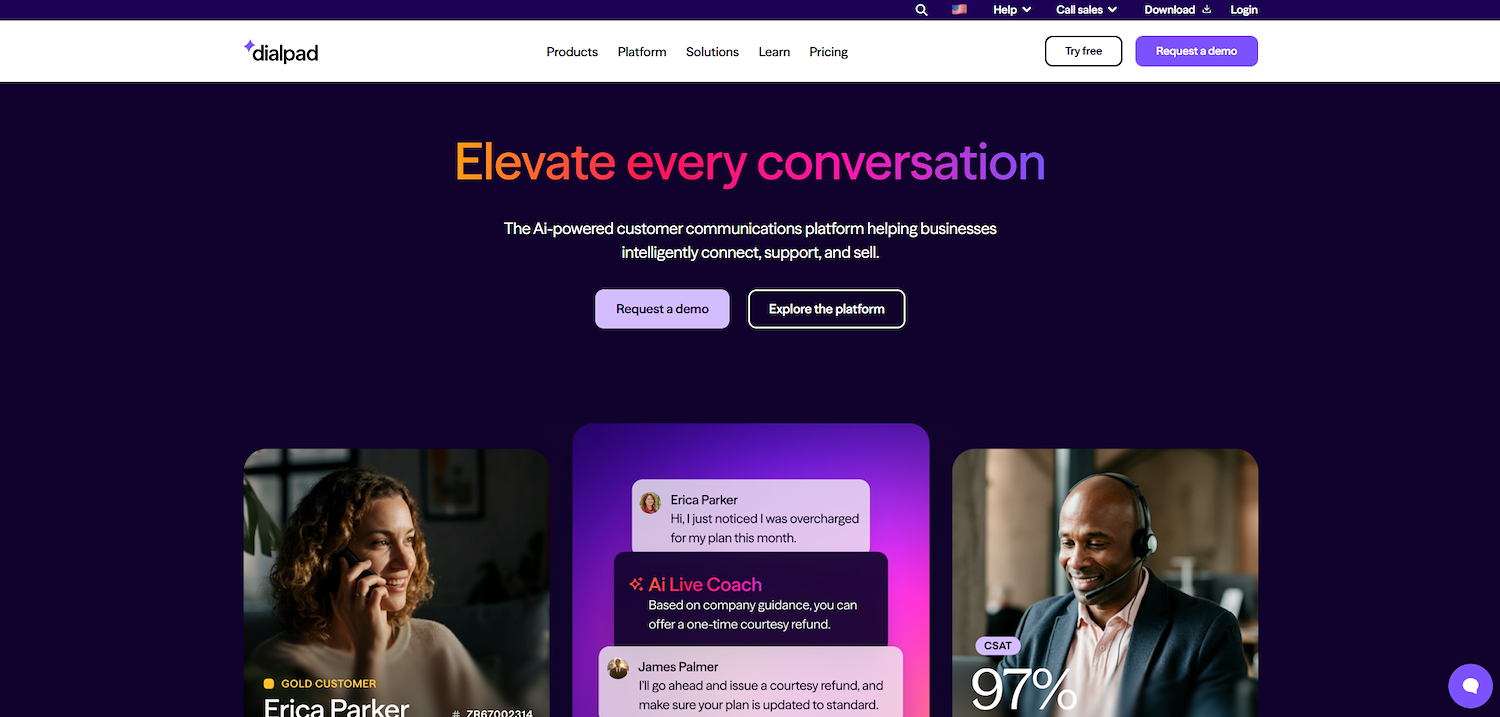
Dialpad Ai Voice is a communications platform that unifies phone calls, messages, and video meetings in one application. It serves companies that connect with customers for support or sales.
The system uses AI to provide real-time transcriptions, summaries, and analytics. For sales, it includes an outbound dialer with live coach functions and workflow automations to improve team performance and reduce call times.
Dialpad Ai Voice's Main Features
- Unifies calling, messaging, video meetings, and contact center functions into a single cloud application.
- Uses a core AI layer for real-time transcription, sentiment analysis, CSAT scoring, and automated action items.
- Includes an outbound sales dialer with real-time AI coaching, insights, and workflow automations.
- Offers a contact center with AI agents, live coaching for support staff, and deep analytics.
How Dialpad Ai Voice Compares to CallHippo
Average Review Score: 4.4/5 stars based on 3,901 G2 reviews.
- Dialpad Ai Voice provides real-time call transcriptions and automated summaries. This offers deeper insights into conversations compared to CallHippo's focus on call connection efficiency.
- It unifies phone calls, video meetings, and messaging into a single application. This contrasts with CallHippo, which operates mainly as a specialized voice platform.
- The tool offers a complete unified communications platform with deep integrations into systems like Google Workspace. CallHippo, in comparison, functions more as a dedicated dialer solution.
- This platform includes AI-powered live coaching and sentiment analysis during calls. This provides a different type of agent support than CallHippo's Power Dialer, which automates call sequences.
Potential Drawbacks Compared to CallHippo
- Some users report issues with customer support. This experience differs from CallHippo, which is often noted for its helpful service.
- The platform's dialer may not offer the same specialized functions as CallHippo's Power Dialer, a feature designed for high-volume outbound teams.
- It can include additional fees for SMS messages. In contrast, CallHippo provides plans that often have more predictable costs for texting.
Pricing and Cost-Effectiveness
Dialpad Ai Voice offers a slightly lower entry point at $15 per user monthly on an annual plan, compared to CallHippo's $16 starter plan. However, CallHippo's mid-tier plan at $24 is more cost-effective than Dialpad's $25 Pro plan. For the most current information, visit Dialpad Ai Voice's official website.
4) Nextiva
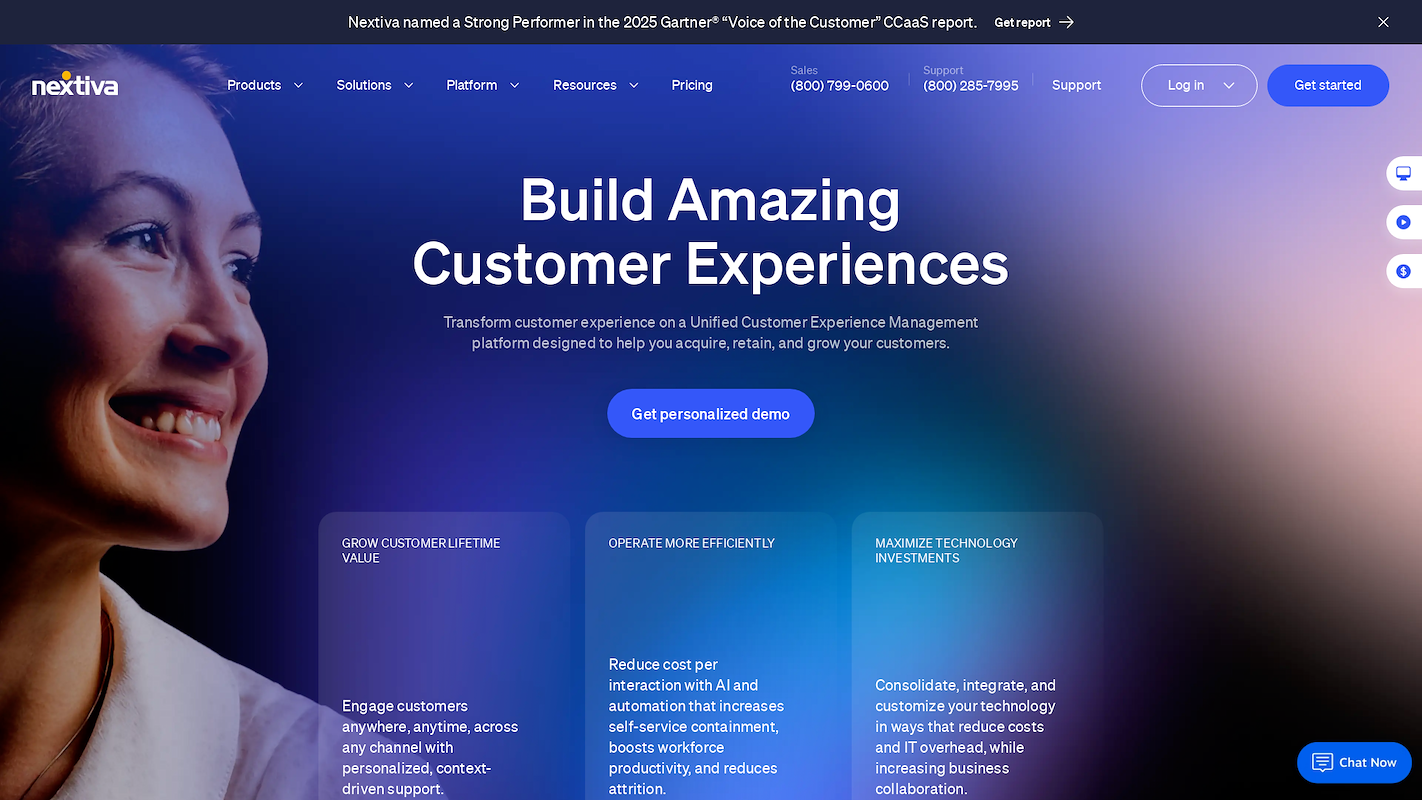
Nextiva offers a business communications platform that combines phone service, video meetings, and team chat. It provides tools for sales, service, and collaboration, all within a single application.
The system is for companies that need to manage customer interactions and internal workflows. It includes a phone dialer for sales teams to handle outbound calls and other features for customer support departments.
Nextiva's Main Features
- Consolidates all customer touch-points, including voice, chat, SMS, and social media, into a single workspace.
- Orchestrates customer journeys with a patented workflow engine that uses built-in AI and automation.
- Provides an AI-powered contact center that uses skills-based and situational routing to direct interactions.
- Features a generative-AI knowledge base to support agents and enable customer self-service.
How Nextiva Compares to CallHippo
Average Review Score: 4.5/5 stars based on 3,333 G2 reviews.
- Nextiva offers a unified platform that includes phone calls, video meetings, and instant messaging. This contrasts with CallHippo's primary focus on voice services.
- The platform uses a workflow engine with AI to manage customer journeys. This offers a different type of automation than CallHippo's Power Dialer, which automates call sequences.
- This tool provides a generative AI knowledge base that assists agents and allows for customer self-service, a feature not found in CallHippo's standard offerings.
- The system integrates multiple communication channels, such as voice, chat, and social media, into one view. This is a broader approach than CallHippo, which centers on voice calls.
Potential Drawbacks Compared To CallHippo
- Nextiva's platform does not include a specialized Power Dialer. This is different from CallHippo, where this feature is central for sales teams that need to make a high volume of outbound calls quickly.
- Some users report that the platform can be complex to navigate. For simple changes, it might be necessary to contact support, which contrasts with CallHippo's reputation for ease of use and straightforward controls.
- The tool sometimes receives criticism for inconsistent customer support and long wait times. This experience differs from CallHippo, which users often praise for its responsive and helpful service team.
- Its contract terms can sometimes include automatic renewals that may be unexpected. CallHippo, in comparison, is often seen as having more transparent and straightforward pricing plans without such clauses.
Pricing and Cost-Effectiveness
CallHippo’s plans are priced at $16, $24, and $40 per user, making it more cost-effective at the entry and mid-levels compared to Nextiva, whose plans start at $20 and $30. While both offer a $40 plan, CallHippo is generally the more budget-friendly choice for teams needing core dialer functions.
5) 8x8 X Series
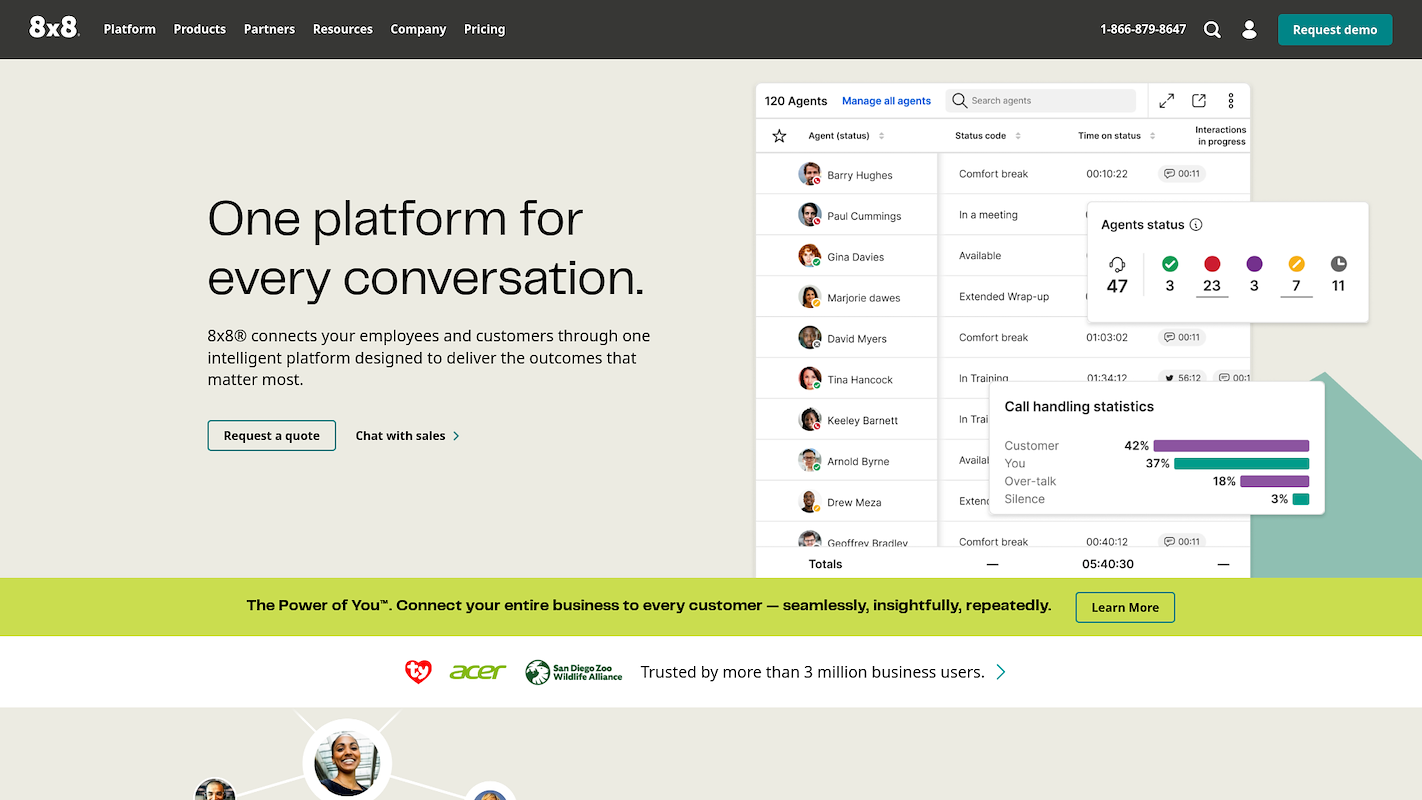
8x8 X Series is a communication platform that combines voice, video, and chat in one application. It serves businesses that manage customer interactions across different channels. The system provides contact center tools for sales and support teams.
These tools include phone dialer functions to handle outbound and inbound calls. This setup allows teams to manage all communications from a single place.
8x8 X Series's Main Features
- Unifies global calling, video meetings, and chat for team collaboration in one application.
- Provides no-code and low-code APIs to embed voice, SMS, and chat channels into any application.
- Adds enterprise telephony and contact center functions natively inside the Microsoft Teams interface.
- Includes an omni-channel contact center that uses built-in AI to manage operations.
How 8x8 X Series Compares To CallHippo
Average Review Score: 4.2/5 stars based on 765 G2 reviews.
- 8x8 X Series provides global phone service in over 55 countries with a 99.999% uptime guarantee, which offers more reliability for international teams than CallHippo's standard service agreements.
- It supports large video meetings with up to 500 participants and YouTube live streaming, a feature set for large-scale collaboration not available in CallHippo's voice-focused platform.
- The platform offers native integration for Microsoft Teams, allowing users to add enterprise telephony directly within the Teams interface. This is a deeper integration compared to CallHippo's available connections.
- This tool includes no-code and low-code APIs to embed communication channels into other applications, providing more development flexibility than CallHippo.
Potential Drawbacks Compared To CallHippo
- 8x8 X Series does not offer a specialized Power Dialer, which is a core feature in CallHippo. For teams that rely on high-volume outbound calls, this might result in a slower calling process compared to the automated sequences in CallHippo.
- Some users report that the platform can be complex to navigate. This is different from CallHippo, which is generally known for a more straightforward and user-friendly interface that allows for quick adoption by new teams.
- The tool can have a longer implementation time of about two months. In contrast, CallHippo is known for a faster setup, which may be more suitable for businesses that need to get their phone system running quickly.
Pricing and Cost-Effectiveness
CallHippo provides clear pricing at $16, $24, and $40 per user. 8x8 X Series does not publish its prices, but its extensive unified communications features suggest a higher cost, making CallHippo the more straightforward choice for teams focused on core dialer functions.
Consider an 11x AI Agent for Sales
For sales efforts beyond phone calls, an 11x digital worker is a useful addition. The AI agents manage lead research, outreach, and follow-ups. This allows your team to concentrate on final sales stages. Find out how an AI agent can support your operations.
At 11x, we use AI to manage the sales process. Our agent Alice identifies accounts, gathers data, and conducts outreach, while Julian qualifies leads and sets meetings. This single platform replaces multiple tools in a standard GTM stack, removing the need for extra software.
Book a demo to see how our AI agents can support your team.
6) Vonage Business Communications
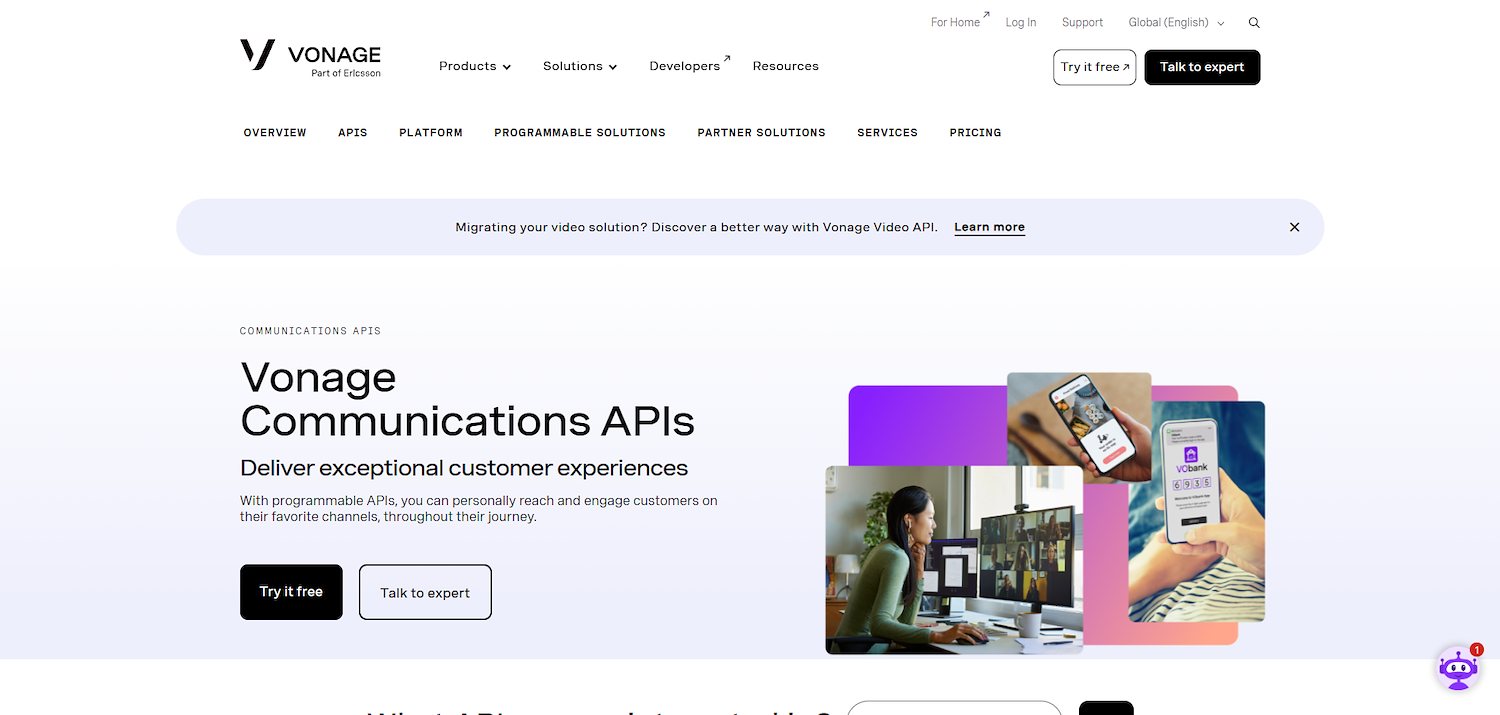
Vonage Business Communications offers a unified platform that combines phone, message, and video services. Companies use it for customer communications and internal teamwork.
The system includes a phone dialer for sales teams to manage outbound calls. It also provides tools for support departments to handle customer interactions within a single application.
Vonage Business Communications's Main Features
- Combines phone, messaging, and video services into a single application.
- Supports both external customer communications and internal team collaboration.
- Provides tools for support departments to handle customer interactions.
How Vonage Business Communications Compares to CallHippo
Average Review Score: 4.3/5 stars based on 484 G2 reviews.
- Vonage Business Communications unifies voice, video, and messaging services into a single platform. This offers more communication channels than CallHippo, which concentrates mainly on voice calls.
- The platform guarantees 99.999% uptime reliability for its service. This provides a more consistent connection compared to CallHippo, where some users note occasional network issues.
- It includes a voicemail-to-email function that sends messages directly to your inbox for easier tracking. This is a convenience feature not central to CallHippo's dialer-focused system.
- This service operates without annual contracts, which gives businesses more flexibility. This is different from other providers that might require a long-term commitment.
Potential Drawbacks Compared To CallHippo
- Vonage Business Communications does not include a specialized Power Dialer. This is different from CallHippo, where this feature is a core tool for sales teams that make a high volume of outbound calls.
- The platform's focus on unified communications means it may lack some of the deep call-center analytics that CallHippo provides. CallHippo offers reports focused specifically on call team performance.
- Its texting capabilities can sometimes be limited. Some users report being unable to reply to or edit texts, which is less flexible than the SMS features available in certain CallHippo plans.
Pricing and Cost-Effectiveness
CallHippo provides clear pricing at $16, $24, and $40 per user. Vonage Business Communications does not publish its prices, but its unified communications features suggest a higher cost, making CallHippo a more straightforward choice for teams focused on core dialer functions.
7) Grasshopper

Grasshopper is a business phone service that provides companies with a professional phone number. The system offers features for sales and support teams to manage their inbound and outbound calls.
Grasshopper's Main Features
- Delivers incoming faxes as PDF attachments directly to an email address.
- Sends an automatic SMS message to new callers when a call is missed using the Instant Response feature.
- Offers an add-on service for a live, U.S.-based virtual receptionist to answer calls.
- Provides a professional voice studio to have custom greetings professionally recorded.
How Grasshopper Compares To CallHippo
Average Review Score: 3.9/5 stars based on 154 G2 reviews.
- Grasshopper delivers incoming faxes as PDF attachments to an email, a feature not central to CallHippo's voice-focused platform.
- The tool sends an automatic SMS to new callers when a call is missed. This differs from CallHippo, which uses automation primarily for its outbound Power Dialer.
- It offers an add-on service for a live virtual receptionist to answer calls, providing a different type of call handling compared to CallHippo's system.
- A professional voice studio is available to record custom greetings. This offers a level of branding customization not found in CallHippo's standard feature set.
Potential Drawbacks Compared To CallHippo
- Grasshopper does not include a Power Dialer. This is a significant difference from CallHippo, which provides this feature for sales teams that need to automate a high volume of outbound calls.
- The platform lacks advanced call analytics. In comparison, CallHippo offers detailed reporting on team performance, which helps managers track key metrics for sales and support operations.
- Some users mention that customer support can be slow to respond. This contrasts with CallHippo, which is generally recognized for providing helpful and timely assistance.
Pricing and Cost-Effectiveness
Grasshopper’s plans are priced at $14, $25, and $55 per month. Its entry point is slightly lower than CallHippo's $16 plan, but CallHippo offers better value at its mid-tier ($24) and top-tier ($40) levels.
8) CloudTalk
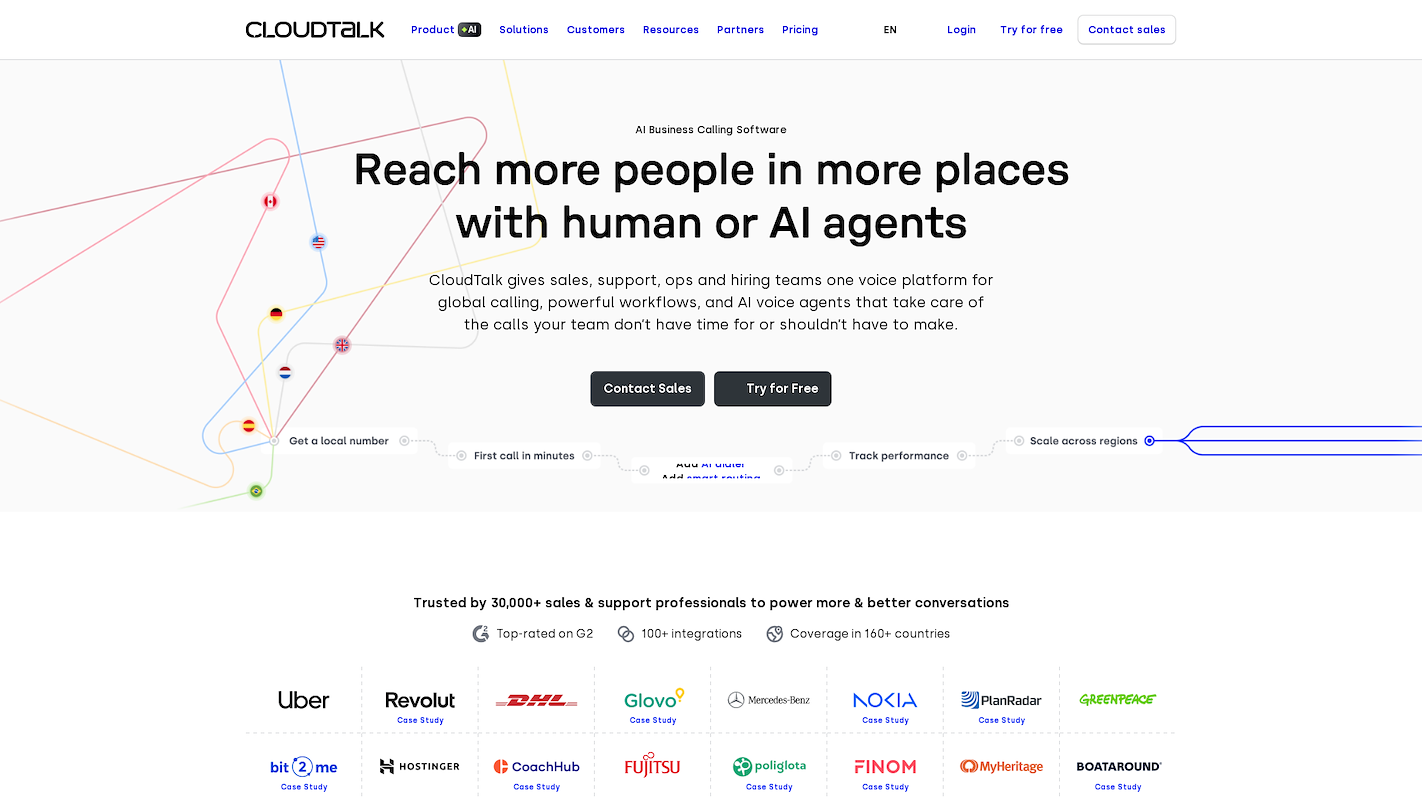
CloudTalk is a cloud phone system for sales and support teams. It provides a phone dialer for outbound call campaigns and tools to manage inbound customer service calls. The system is built for call center environments.
It also connects with CRM and helpdesk applications to centralize customer data and interaction history from multiple sources.
CloudTalk's Main Features
- Routes and queues calls to manage inbound communication flow.
- Supports concurrent calling to handle multiple conversations at once.
- Includes session summary notes for agents to document calls.
- Provides reporting and dashboards for administrative oversight.
How CloudTalk Compares To CallHippo
Average Review Score: 4.4/5 stars based on 1,384 G2 reviews.
- CloudTalk provides service in over 160 countries, which offers broader global coverage for international teams compared to CallHippo.
- It includes AI-powered coaching and call transcripts. This gives managers detailed insights into agent performance, a different focus from CallHippo's Power Dialer.
- The platform offers a drag-and-drop workflow builder to automate various tasks. This allows for more process customization than CallHippo's automated dialing.
- This tool emphasizes high call quality. This focus on clarity differs from CallHippo, which prioritizes call volume and connection speed for outbound teams.
Potential Drawbacks Compared To CallHippo
- Some users report occasional issues with call stability or dropped connections. This is a factor to weigh, as CallHippo's system is built around maintaining a high volume of outbound calls.
- The platform sometimes presents challenges with third-party software integrations. CallHippo, in contrast, provides a more direct setup, although its integration options are less extensive.
- It may lack certain specific functions that some teams require. This is different from CallHippo, which concentrates on a core set of established features centered around its Power Dialer.
Pricing and Cost-Effectiveness
CallHippo's plans cost $16, $24, and $40 per user monthly. CloudTalk's pricing is listed at $19, $29, and $49 per user annually. This positions CloudTalk as a more budget-friendly option, as its yearly cost is lower than a single month's fee for any CallHippo plan.
9) Talkdesk
Talkdesk is a cloud contact center platform that uses AI to manage customer interactions. It is designed for large-scale sales and service operations that require a comprehensive suite of tools for customer experience management.
Talkdesk's Main Features
- Provides AI-powered tools for agent assistance, automation, and analytics.
- Offers omnichannel support to manage interactions across voice, email, chat, and social media.
- Includes workforce engagement management for scheduling, coaching, and performance tracking.
- Delivers industry-specific solutions tailored for sectors like healthcare and financial services.
How Talkdesk Compares To CallHippo
Average Review Score: 4.5/5 stars based on 2,111 G2 reviews.
- Talkdesk is an enterprise-grade contact center platform. This scope is much broader than CallHippo, which functions primarily as a business phone and dialer system.
- It uses AI to automate workflows and provide real-time agent guidance. This is a different approach to automation than CallHippo's Power Dialer, which focuses on call sequencing.
- The platform offers solutions built for specific industries. This provides more tailored functionality compared to CallHippo's general-purpose toolset.
- It includes integrated workforce management tools. These features for scheduling and agent development are not part of CallHippo's core offering.
Potential Drawbacks Compared To CallHippo
- The platform's extensive features can result in a higher price point and more complex implementation. This may be a consideration for smaller teams or those with simple needs.
- It may not have a dedicated Power Dialer with the same specific functionality as CallHippo's. Teams focused on high-volume outbound campaigns might find CallHippo more direct for that task.
- The system can have a steeper learning curve due to its wide range of capabilities. CallHippo is often considered more straightforward for new users to adopt.
Pricing and Cost-Effectiveness
Talkdesk offers custom pricing based on the specific needs of an enterprise, which means costs are not publicly listed. In contrast, CallHippo’s transparent plans at $16, $24, and $40 make it a more predictable and budget-friendly choice for teams that need core dialer functions.
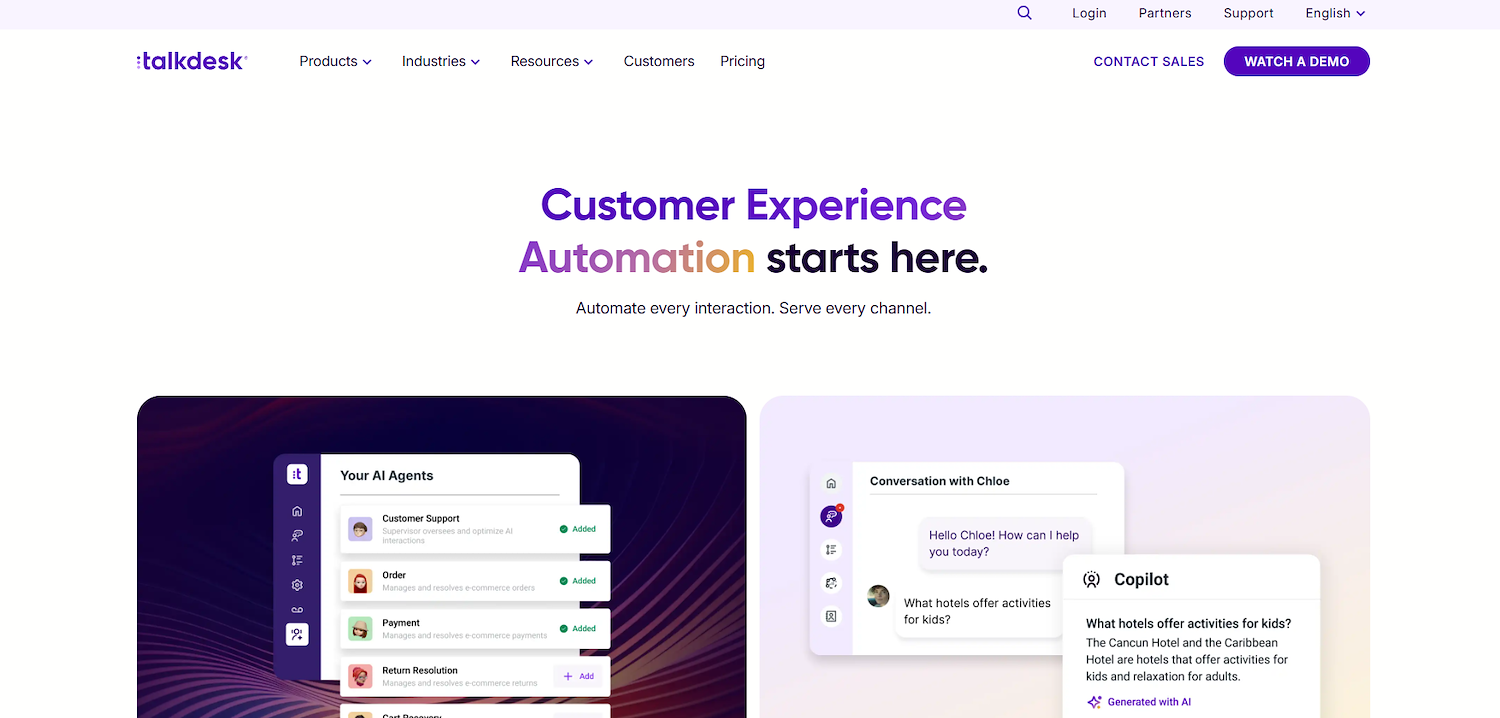
Talkdesk is a cloud contact center platform that uses AI to manage customer interactions. It is built for large sales and service operations that need a full suite of tools for customer experience management. The platform offers omnichannel support across voice, email, and chat.
For dialer functions, it supports sales teams with AI-powered agent assistance and automation. This differs from a dedicated power dialer system.
Talkdesk's Main Features
- Routes and queues sessions to manage the flow of inbound communication.
- Supports concurrent calling to handle multiple conversations at once.
- Includes session summary notes for agents to document calls.
- Provides reporting and dashboards for administrative oversight.
How Talkdesk Compares To CallHippo
Average Review Score: 4.4/5 stars based on 2,431 G2 reviews.
- Talkdesk provides AI-powered tools for agent assistance and workflow automation. This differs from CallHippo, which uses automation mainly for its Power Dialer to sequence outbound calls.
- It offers omnichannel support to manage customer interactions across voice, email, and chat. This is a broader approach compared to CallHippo's primary focus on voice communication.
- The platform delivers solutions tailored for specific industries, such as healthcare and financial services. This provides more specialized functions than CallHippo's general-purpose toolset.
- This tool includes workforce engagement features for agent scheduling and performance tracking. These capabilities are not a central part of CallHippo's system.
Potential Drawbacks Compared To CallHippo
- Talkdesk does not include a specialized Power Dialer, which is a core feature of CallHippo. This means sales teams cannot automate high-volume outbound call sequences in the same way.
- The platform's pricing is designed for enterprise budgets, with plans starting at $85 per user. In contrast, CallHippo provides more accessible pricing for small to mid-sized teams.
- Its system is comprehensive and may be too complex for teams that only need basic phone services. CallHippo offers a more focused toolset that is simpler to manage for core calling tasks.
Pricing and Cost-Effectiveness
CallHippo offers plans at $16, $24, and $40 per user. Talkdesk's pricing starts at $85 per user per month. This positions CallHippo as the more cost-effective choice for teams needing core dialer functions, while Talkdesk's pricing reflects its comprehensive, enterprise-focused platform.
10) Freshdesk Contact Center
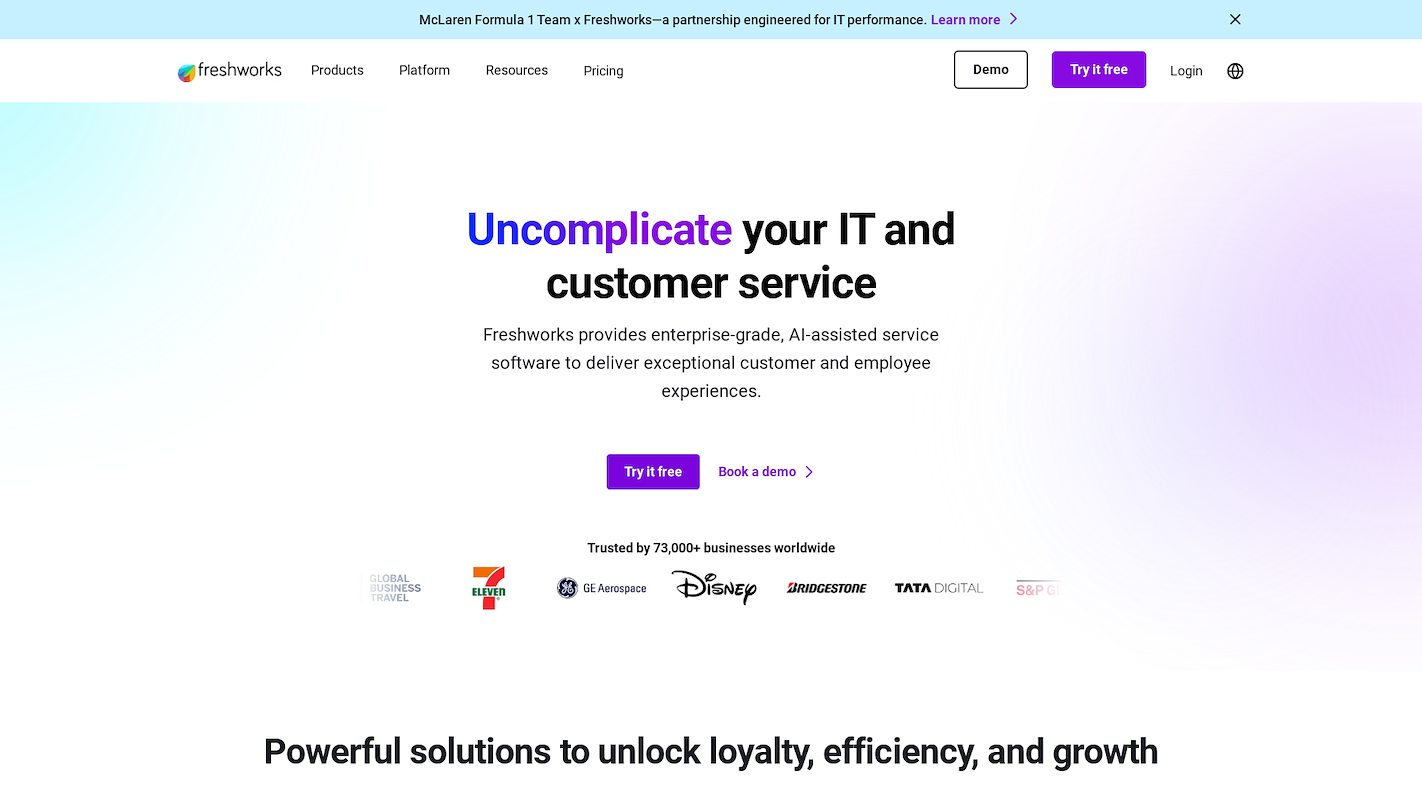
Freshdesk Contact Center is a cloud phone system for sales and support teams. It offers tools to manage inbound and outbound customer calls. The platform includes phone dialer functions for departments that conduct sales outreach and is part of the Freshworks product suite.
Freshdesk Contact Center's Main Features
- Manages customer interactions across both voice and email channels.
- Routes and queues incoming sessions to manage communication flow.
- Supports concurrent calling to handle multiple conversations at once.
- Includes session summary notes for agents to document calls.
How Freshdesk Contact Center Compares To CallHippo
Average Review Score: 4.1/5 stars based on 142 G2 reviews.
- Freshdesk Contact Center provides a free plan for teams starting out. This is different from CallHippo, which requires a paid subscription for all its tiers.
- It offers local phone numbers in over 90 countries. This gives businesses more options for a global presence compared to the standard international numbers from CallHippo.
- The tool integrates natively with the Freshworks ecosystem, including its helpdesk and CRM. This creates a more unified workflow than connecting CallHippo to separate applications.
- This platform allows agents to manage calls on dedicated mobile apps for both Android and iOS, offering more flexibility for remote work than a system primarily focused on desktop use.
Potential Drawbacks Compared To CallHippo
- Freshdesk Contact Center does not include a specialized Power Dialer. This is different from CallHippo, where this feature is a core tool for sales teams that need to automate a high volume of outbound calls.
- Its analytics are part of a broader contact center suite. In comparison, CallHippo provides reports that focus specifically on dialer and call team performance, which may offer more detail for outbound sales managers.
- Some users report that customer support can be slow to resolve issues. This experience differs from CallHippo, which is generally recognized for its responsive and helpful service team.
Pricing and Cost-Effectiveness
Freshdesk Contact Center offers a free plan and paid tiers at $15, $39, and $69 per user. CallHippo’s plans are $16, $24, and $40. Freshdesk is more accessible for new teams with its free option, while CallHippo provides more cost-effective mid-tier and premium plans for teams needing more features.
Which One Should You Go With?
Choosing the right CallHippo alternative depends on your specific business needs, team size, and budget. This guide has outlined the top options, comparing their features and costs to help you make an informed decision.
If your sales process involves more than just calling, consider an AI agent from 11x. These digital workers can handle tasks like lead research, outreach, and follow-ups, allowing your sales team to focus on closing deals and strategic activities.



